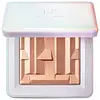Rare Beauty Positive Light Silky Touch Highlighter Versus Haus Labs By Lady Gaga Bio-Radiant Gel-Powder Highlighter
What's inside
What's inside
 Key Ingredients
Key Ingredients

 Benefits
Benefits

 Concerns
Concerns

 Ingredients Side-by-side
Ingredients Side-by-side

Mica
Cosmetic ColorantSynthetic Fluorphlogopite
Cetearyl Ethylhexanoate
EmollientHdi/Trimethylol Hexyllactone Crosspolymer
Silica
AbrasiveGlycerin
HumectantPseudozyma Epicola/Sunflower Seed Oil Ferment Extract Filtrate
Emulsion StabilisingArnica Montana Flower Extract
MaskingSqualane
EmollientActinidia Polygama Fruit Extract
Skin ConditioningTocopherol
AntioxidantAscorbyl Palmitate
AntioxidantTocopheryl Acetate
AntioxidantEthylhexylglycerin
Skin ConditioningGellan Gum
Caprylyl Glycol
EmollientCalcium Chloride
AstringentButylene Glycol
HumectantDicalcium Phosphate
AbrasivePentaerythrityl Tetra-Di-T-Butyl Hydroxyhydrocinnamate
Antioxidant1,2-Hexanediol
Skin ConditioningPolysorbate 20
EmulsifyingWater
Skin ConditioningTin Oxide
AbrasiveCI 77491
Cosmetic ColorantCI 77891
Cosmetic ColorantMica, Synthetic Fluorphlogopite, Cetearyl Ethylhexanoate, Hdi/Trimethylol Hexyllactone Crosspolymer, Silica, Glycerin, Pseudozyma Epicola/Sunflower Seed Oil Ferment Extract Filtrate, Arnica Montana Flower Extract, Squalane, Actinidia Polygama Fruit Extract, Tocopherol, Ascorbyl Palmitate, Tocopheryl Acetate, Ethylhexylglycerin, Gellan Gum, Caprylyl Glycol, Calcium Chloride, Butylene Glycol, Dicalcium Phosphate, Pentaerythrityl Tetra-Di-T-Butyl Hydroxyhydrocinnamate, 1,2-Hexanediol, Polysorbate 20, Water, Tin Oxide, CI 77491, CI 77891
 Reviews
Reviews

Ingredients Explained
These ingredients are found in both products.
Ingredients higher up in an ingredient list are typically present in a larger amount.
1,2-Hexanediol is a synthetic liquid and another multi-functional powerhouse.
It is a:
- Humectant, drawing moisture into the skin
- Emollient, helping to soften skin
- Solvent, dispersing and stabilizing formulas
- Preservative booster, enhancing the antimicrobial activity of other preservatives
Caprylyl Glycol is a humectant and emollient, meaning it attracts and preserves moisture.
It is a common ingredient in many products, especially those designed to hydrate skin. The primary benefits are retaining moisture, skin softening, and promoting a healthy skin barrier.
Though Caprylyl Glycol is an alcohol derived from fatty acids, it is not the kind that can dry out skin.
This ingredient is also used as a preservative to extend the life of products. It has slight antimicrobial properties.
Learn more about Caprylyl GlycolCi 77491 is also hydrated iron III oxide. It's sole purpose is to give a red/pink hue to products.
Iron III oxides are classified as inorganic chemicals for coloring.
Synthetically created Ci 77491 is considered safer than those naturally found. This is because the synthetically created version may contain less impurities. Iron oxides are generally non-toxic and non-allergenic.
Learn more about CI 77491Ci 77891 is a white pigment from Titanium dioxide. It is naturally found in minerals such as rutile and ilmenite.
It's main function is to add a white color to cosmetics. It can also be mixed with other colors to create different shades.
Ci 77891 is commonly found in sunscreens due to its ability to block UV rays.
Learn more about CI 77891Silica, also known as silicon dioxide, is a naturally occurring mineral. It is used as a fine, spherical, and porous powder in cosmetics.
Though it has exfoliant properties, the function of silica varies depending on the product.
The unique structure of silica enhances the spreadability and adds smoothness, making it a great texture enhancer.
It is also used as an active carrier, emulsifier, and mattifier due to its ability to absorb excess oil.
In some products, tiny microneedles called spicules are made from silica or hydrolyzed sponge. When you rub them in, they lightly polish away dead skin layers and enhance the penetration of active ingredients.
Learn more about SilicaSynthetic Fluorphlogopite is the synthethic version of mica. It consists of fluorine, aluminum and silicate.
Synthetic Fluorphlogopite is used to add volume to products.
It is considered non-irritating on the skin.
Learn more about Synthetic FluorphlogopiteTin Oxide is an inorganic oxide used to add opacity and volume to a product. In nature, it is already found in mineral form. The main ore of tin is an opaque and shiny mineral called casseterite.
Tin Oxide helps remove translucency in a product, or make it more opaque. Besides adding opacity, tin oxide is used for bulking to add volume.